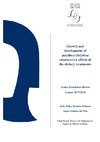Please use this identifier to cite or link to this item:
https://accedacris.ulpgc.es/jspui/handle/10553/75062
| DC Field | Value | Language |
|---|---|---|
| dc.contributor.advisor | Robaina Robaina, Lidia Esther | - |
| dc.contributor.advisor | Santana Del Pino, Ángelo | - |
| dc.contributor.author | Hernández Rivero, Laura | - |
| dc.date.accessioned | 2020-10-28T09:48:23Z | - |
| dc.date.available | 2020-10-28T09:48:23Z | - |
| dc.date.issued | 2018 | en_US |
| dc.identifier.uri | https://accedacris.ulpgc.es/handle/10553/75062 | - |
| dc.description.abstract | Palythoa canariensis is a soft coral endemic to the Canary Islands. Previous studies show that this species adapts well to culture conditions and, like other species of the genus Palythoa, produces palytoxin. From previous studies blue light resulted in best animal performance although the growth of the animals difficult to define due to the appearance of polyps. In present study, for the first time, 2 specific diets for this species were assayed against blue light and 2 different depths of the aquariums on the growth of the animals. A feed formulation based on a common commercial aquarium feed was prepared and used as a control and, based on that, a source of bioactive polyphenols well know as growth and health promoters was included in a second diet. Aloe vera byproduct, locally generated from the aloe gel production, was selected as key ingredient in present case and after processing and analysis included at a 2% in the formula feed. Results showed that the greatest increase in weight and the highest number of polyps was obtained for the control diet and the lower depth 13 cm. As contaminants did not differ among diets, this indicates a possible negative effect of the dietary polyphenol content on the growth and development of these animals, which should be deepened in subsequent studies. | en_US |
| dc.language | eng | en_US |
| dc.relation | R+D+I Towards aquaponic development in the up islands and the circular economy | en_US |
| dc.subject | 251092 Acuicultura marina | en_US |
| dc.subject.other | Palythoa canariensis | es |
| dc.title | Growth and developmentof palythoa (Palythoa canariensis) : effects of the dietary treatments | en_US |
| dc.type | info:eu-repo/semantics/bachelorThesis | en_US |
| dc.type | BachelorThesis | en_US |
| dc.contributor.departamento | Departamento de Biología | en_US |
| dc.contributor.departamento | Departamento de Matemáticas | - |
| dc.contributor.facultad | Facultad de Ciencias del Mar | en_US |
| dc.investigacion | Ciencias | en_US |
| dc.type2 | Trabajo final de grado | en_US |
| dc.identifier.matricula | TFT-46508 | es |
| dc.identifier.ulpgc | Sí | en_US |
| dc.contributor.buulpgc | BU-BAS | en_US |
| dc.contributor.titulacion | Grado en Ciencias del Mar | es |
| item.fulltext | Con texto completo | - |
| item.grantfulltext | restricted | - |
| crisitem.project.principalinvestigator | Robaina Robaina, Lidia Esther | - |
| crisitem.advisor.dept | GIR Grupo de Investigación en Acuicultura | - |
| crisitem.advisor.dept | IU de Investigación en Acuicultura Sostenible y Ec | - |
| crisitem.advisor.dept | Departamento de Biología | - |
| crisitem.advisor.dept | Departamento de Matemáticas | - |
| Appears in Collections: | Trabajo final de grado Restringido ULPGC | |
Page view(s)
128
checked on Mar 1, 2025
Download(s)
40
checked on Mar 1, 2025
Google ScholarTM
Check
Share
Export metadata
Items in accedaCRIS are protected by copyright, with all rights reserved, unless otherwise indicated.
